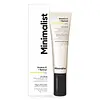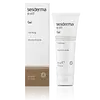What's inside
What's inside
 Key Ingredients
Key Ingredients

 Benefits
Benefits

 Concerns
Concerns

 Ingredients Side-by-side
Ingredients Side-by-side

Water
Skin ConditioningGlycerin
HumectantNiacinamide
SmoothingDimethicone
EmollientPropanediol
SolventCaffeine
Skin ConditioningDicaprylyl Carbonate
EmollientBrassica Glycerides
EmollientDiisopropyl Sebacate
EmollientMaltodextrin
AbsorbentGlyceryl Glucoside
HumectantBehenyl Alcohol
EmollientButylene Glycol
HumectantPhytonadione Epoxide
AstringentPrunus Amygdalus Dulcis Oil
Skin ConditioningHydroxyethylcellulose
Emulsion StabilisingPentylene Glycol
Skin ConditioningHydrolyzed Sodium Hyaluronate
Skin ConditioningZerumbone
Skin ConditioningN-Hydroxysuccinimide
Skin ConditioningDipeptide-2
Skin ConditioningSteareth-20
CleansingChrysin
Skin ConditioningPalmitoyl Tetrapeptide-7
Skin ConditioningXanthan Gum
EmulsifyingRetinal
Skin ConditioningSodium Hyaluronate
HumectantHesperidin Methyl Chalcone
AntioxidantPhenoxyethanol
PreservativeCarbomer
Emulsion StabilisingPalmitoyl Tripeptide-1
Skin ConditioningEthylhexylglycerin
Skin ConditioningCitric Acid
BufferingTrisodium Ethylenediamine Disuccinate
Water, Glycerin, Niacinamide, Dimethicone, Propanediol, Caffeine, Dicaprylyl Carbonate, Brassica Glycerides, Diisopropyl Sebacate, Maltodextrin, Glyceryl Glucoside, Behenyl Alcohol, Butylene Glycol, Phytonadione Epoxide, Prunus Amygdalus Dulcis Oil, Hydroxyethylcellulose, Pentylene Glycol, Hydrolyzed Sodium Hyaluronate, Zerumbone, N-Hydroxysuccinimide, Dipeptide-2, Steareth-20, Chrysin, Palmitoyl Tetrapeptide-7, Xanthan Gum, Retinal, Sodium Hyaluronate, Hesperidin Methyl Chalcone, Phenoxyethanol, Carbomer, Palmitoyl Tripeptide-1, Ethylhexylglycerin, Citric Acid, Trisodium Ethylenediamine Disuccinate
Water
Skin ConditioningGlycerin
HumectantPropanediol
SolventPEG-40 Hydrogenated Castor Oil
EmulsifyingAmmonium Acryloyldimethyltaurate/Vp Copolymer
Phosphatidylcholine
EmulsifyingCyclopentasiloxane
EmollientAesculus Hippocastanum Seed Extract
Skin ConditioningAlcohol
AntimicrobialButylene Glycol
HumectantCamphanediol
Skin ConditioningCaprylyl Glycol
EmollientDecyl Glucoside
CleansingDimethicone
EmollientDisodium EDTA
Ethylhexylglycerin
Skin ConditioningGinkgo Biloba Leaf Extract
Skin ConditioningGlycine Soja Protein
EmulsifyingHexylene Glycol
EmulsifyingHydrolyzed Rice Bran Protein
Skin ConditioningMethylsilanol Mannuronate
Skin ConditioningParfum
MaskingPhenoxyethanol
PreservativePhytonadione Epoxide
AstringentPinanediol
Skin ConditioningPolysilicone-11
Polysorbate 20
EmulsifyingPotassium Sorbate
PreservativePropylene Glycol
HumectantSodium Benzoate
MaskingSodium Chloride
MaskingSodium Cholate
Skin ConditioningSodium Dextran Sulfate
Gel FormingSodium Hyaluronate
HumectantSodium Hydroxide
BufferingSorbic Acid
PreservativeSuperoxide Dismutase
AntioxidantWater, Glycerin, Propanediol, PEG-40 Hydrogenated Castor Oil, Ammonium Acryloyldimethyltaurate/Vp Copolymer, Phosphatidylcholine, Cyclopentasiloxane, Aesculus Hippocastanum Seed Extract, Alcohol, Butylene Glycol, Camphanediol, Caprylyl Glycol, Decyl Glucoside, Dimethicone, Disodium EDTA, Ethylhexylglycerin, Ginkgo Biloba Leaf Extract, Glycine Soja Protein, Hexylene Glycol, Hydrolyzed Rice Bran Protein, Methylsilanol Mannuronate, Parfum, Phenoxyethanol, Phytonadione Epoxide, Pinanediol, Polysilicone-11, Polysorbate 20, Potassium Sorbate, Propylene Glycol, Sodium Benzoate, Sodium Chloride, Sodium Cholate, Sodium Dextran Sulfate, Sodium Hyaluronate, Sodium Hydroxide, Sorbic Acid, Superoxide Dismutase
Ingredients Explained
These ingredients are found in both products.
Ingredients higher up in an ingredient list are typically present in a larger amount.
Butylene Glycol (or BG) is used within cosmetic products for a few different reasons:
Overall, Butylene Glycol is a safe and well-rounded ingredient that works well with other ingredients.
Though this ingredient works well with most skin types, some people with sensitive skin may experience a reaction such as allergic rashes, closed comedones, or itchiness.
Learn more about Butylene GlycolDimethicone is a type of synthetic silicone created from natural materials such as quartz.
What it does:
Dimethicone comes in different viscosities:
Depending on the viscosity, dimethicone has different properties.
Ingredients lists don't always show which type is used, so we recommend reaching out to the brand if you have questions about the viscosity.
This ingredient is unlikely to cause irritation because it does not get absorbed into skin. However, people with silicone allergies should be careful about using this ingredient.
Note: Dimethicone may contribute to pilling. This is because it is not oil or water soluble, so pilling may occur when layered with products. When mixed with heavy oils in a formula, the outcome is also quite greasy.
Learn more about DimethiconeEthylhexylglycerin (we can't pronounce this either) is commonly used as a preservative and skin softener. It is derived from glyceryl.
You might see Ethylhexylglycerin often paired with other preservatives such as phenoxyethanol. Ethylhexylglycerin has been found to increase the effectiveness of these other preservatives.
Glycerin is already naturally found in your skin. It helps moisturize and protect your skin.
A study from 2016 found glycerin to be more effective as a humectant than AHAs and hyaluronic acid.
As a humectant, it helps the skin stay hydrated by pulling moisture to your skin. The low molecular weight of glycerin allows it to pull moisture into the deeper layers of your skin.
Hydrated skin improves your skin barrier; Your skin barrier helps protect against irritants and bacteria.
Glycerin has also been found to have antimicrobial and antiviral properties. Due to these properties, glycerin is often used in wound and burn treatments.
In cosmetics, glycerin is usually derived from plants such as soybean or palm. However, it can also be sourced from animals, such as tallow or animal fat.
This ingredient is organic, colorless, odorless, and non-toxic.
Glycerin is the name for this ingredient in American English. British English uses Glycerol/Glycerine.
Learn more about GlycerinPhenoxyethanol is a preservative that has germicide, antimicrobial, and aromatic properties. Studies show that phenoxyethanol can prevent microbial growth. By itself, it has a scent that is similar to that of a rose.
It's often used in formulations along with Caprylyl Glycol to preserve the shelf life of products.
We don't have a description for Phytonadione Epoxide yet.
Propanediol is an all-star ingredient. It softens, hydrates, and smooths the skin.
It’s often used to:
Propanediol is not likely to cause sensitivity and considered safe to use. It is derived from corn or petroleum with a clear color and no scent.
Learn more about PropanediolSodium Hyaluronate is hyaluronic acid's salt form. It is commonly derived from the sodium salt of hyaluronic acid.
Like hyaluronic acid, it is great at holding water and acts as a humectant. This makes it a great skin hydrating ingredient.
Sodium Hyaluronate is naturally occurring in our bodies and is mostly found in eye fluid and joints.
These are some other common types of Hyaluronic Acid:
Learn more about Sodium HyaluronateWater. It's the most common cosmetic ingredient of all. You'll usually see it at the top of ingredient lists, meaning that it makes up the largest part of the product.
So why is it so popular? Water most often acts as a solvent - this means that it helps dissolve other ingredients into the formulation.
You'll also recognize water as that liquid we all need to stay alive. If you see this, drink a glass of water. Stay hydrated!
Learn more about Water